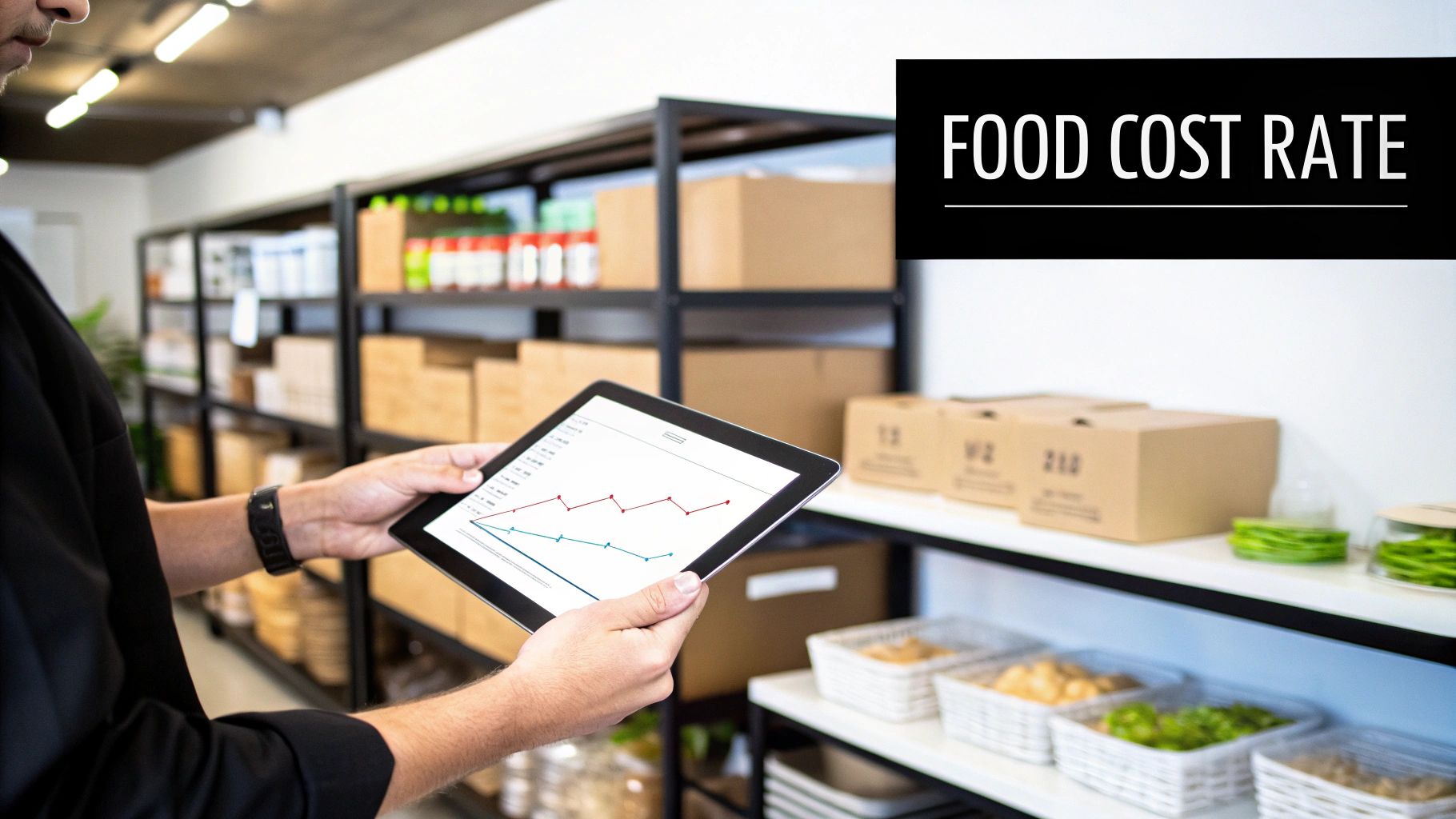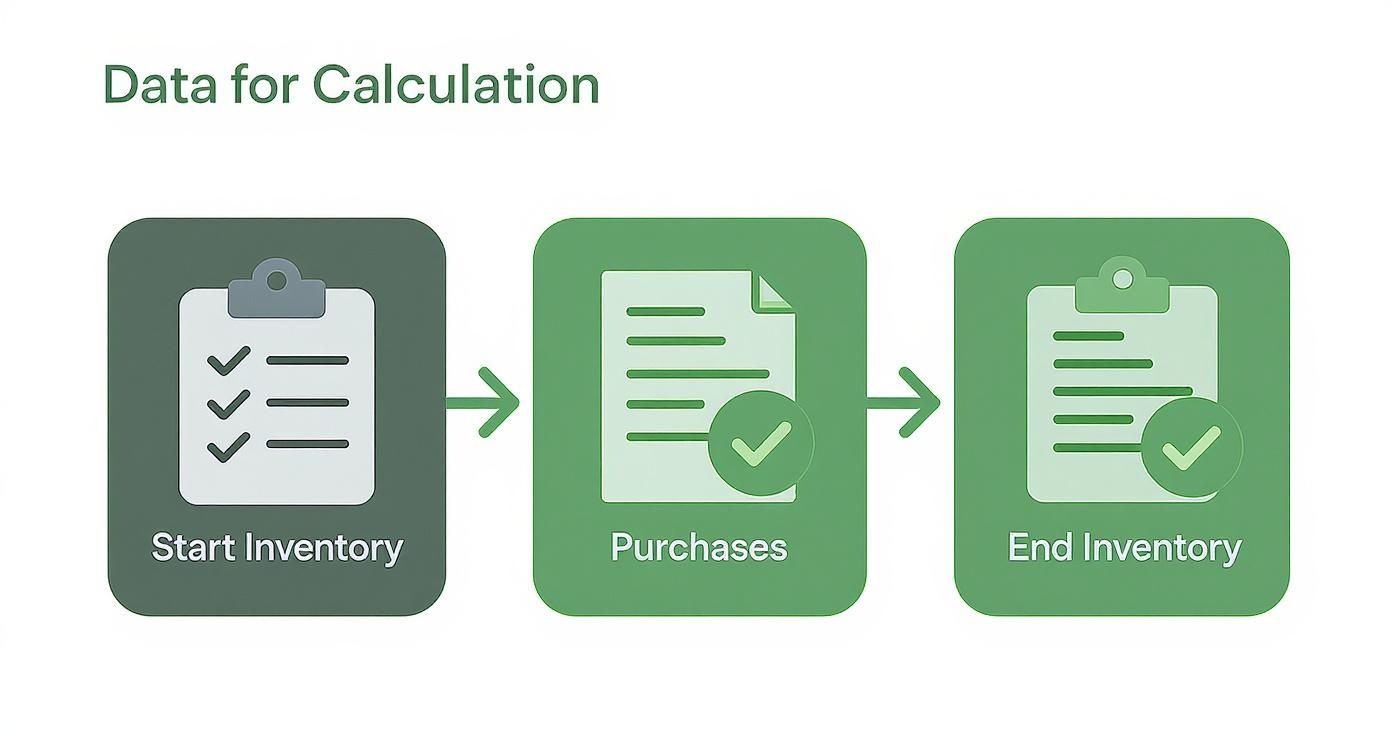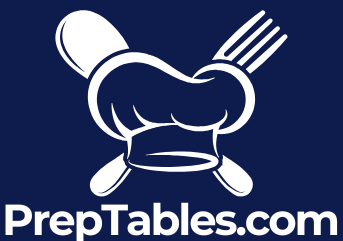
Master Your Menu with a food cost percentage calculator
Share
A restaurant's food cost percentage is just the ratio of your ingredient costs to your menu sales. That's it. But getting a handle on this number is arguably the single most important factor in your restaurant's financial health. A good food cost percentage calculator is the first tool you need to get that control.
Why Food Cost Percentage Is a Critical Restaurant Metric

Let’s be real for a minute. Running a restaurant is a numbers game. Your passion for amazing food is what gets you in the door, but it’s a solid grasp of the numbers that keeps those doors open for years to come. The most crucial number of all? Your food cost percentage. This metric is a direct reflection of your kitchen's efficiency and, ultimately, your profitability.
Think of it as your restaurant's financial pulse. It tells you exactly how much of every single dollar a customer spends is going right back out the door to pay for ingredients. Without this insight, you’re flying blind. You end up making huge decisions about menu pricing and inventory based on gut feelings instead of hard data.
The Real-World Impact on Your Bottom Line
I've seen it happen dozens of time. Picture a small bistro that looks like a huge success—packed dining room every single night. But the owner is scratching their head because profits are somehow shrinking, even with great sales. After finally running the numbers with a food cost calculator, they discover their food costs have crept up from an ideal 30% to nearly 40% over just six months.
That silent 10% increase was eating their entire profit margin alive. The culprits were all small, seemingly unnoticeable things: a produce supplier raising prices slightly, a new line cook being a bit generous with portions, and minor spoilage that was never tracked. This scenario is incredibly common, and it’s a perfect example of why you have to monitor your costs constantly.
A high food cost percentage is a silent profit killer. A small, unchecked increase can turn a successful month into a financial loss, even when sales are strong.
Navigating Rising Ingredient Prices
Keeping these costs in check has become a serious challenge lately. Since the end of 2019, we've all seen food prices surge like crazy. As of May 2025, overall food prices had shot up 29.5%, which is even faster than the general inflation rate of 23.9%. What’s really hitting restaurants is that the cost of food consumed away from home—the very ingredients we all buy—jumped even higher at 31.9%. You can dig into the specifics of these food price inflation trends on farmdocdaily.illinois.edu.
In an environment like this, a food cost percentage calculator isn't just a handy tool; it's a strategic necessity. It gives you the power to:
- Set menu prices that actually guarantee profitability.
- Pinpoint and slash kitchen waste.
- Fine-tune your inventory orders to stop tying up cash in overstock.
- Make smarter, data-driven decisions about your suppliers and ingredients.
Gathering the Right Data for an Accurate Calculation
Your food cost calculation is only as good as the numbers you plug into it. Before you even think about using a calculator, you need to lock down the three pillars of the equation: your beginning inventory, all purchases made during the period, and your ending inventory. It's the classic "garbage in, garbage out" scenario, and it's especially true when it comes to your restaurant's finances.
First up, you need a precise valuation of your beginning inventory. This is simply the total dollar value of all the food and beverage stock you have sitting on your shelves at the start of your chosen period—say, the first day of the month. Think of it as a snapshot in time that sets your baseline.
Next, you have to meticulously track all your purchases. This means every single invoice for food and drink that came through the door during that period needs to be collected and totaled. You can't let anything slip through the cracks; even one small missing invoice can throw your final percentage off.
Finalizing Your Inventory Count
The last piece of the puzzle is your ending inventory, which is the value of all the stock you have left at the end of the period. This is where so many kitchens stumble. A proven method is the "shelf-to-sheet" approach. You physically count items in the exact order they appear on your shelves—left to right, top to bottom. This systematic process is your best defense against double-counting or missing anything.
Pro Tip: For those partially used bulk items, like a 50-pound bag of flour, just estimate the value based on what's left. If the bag is about half-full and cost you $20, you'd value it at $10. The key here is consistency, not trying to achieve impossible precision.
If you want to dig deeper into making this whole process smoother, exploring different inventory management best practices can make a huge difference in both your accuracy and the time you spend counting. For a truly tight grip on your numbers, many operators find that implementing advanced inventory management solutions is a game-changer.
Once you have these three key numbers—Beginning Inventory, Purchases, and Ending Inventory—you're ready to get an accurate calculation. The checklist below will help you get everything organized before you move on.
Data Checklist for Accurate Food Cost Calculation
Before you start crunching numbers, run through this checklist to make sure you have everything you need. Having this information ready and organized will make the entire process faster and far more accurate.
| Data Point | Description | Where to Find It |
|---|---|---|
| Beginning Inventory Value | The total dollar value of all food stock at the start of the period. | Previous period's ending inventory sheet. |
| Total Purchases Value | The sum of all food and beverage invoices received during the period. | Supplier invoices and purchasing records. |
| Ending Inventory Value | The total dollar value of all food stock at the end of the period. | A physical count of current stock on hand. |
With these data points collected and verified, you have the solid foundation required for an accurate food cost calculation.
Breaking Down the Food Cost Percentage Formula
Forget the complicated accounting jargon for a minute. The formula behind any decent food cost percentage calculator is actually pretty simple once you see its three core parts. This one calculation gives you a clear, powerful number that shows how your kitchen is really performing financially over a specific period, whether it's a week or a month.
The first piece of the puzzle is figuring out your Cost of Goods Sold (COGS). Now, this isn't just the total from your recent food delivery invoices. COGS is a measure of the actual ingredients you consumed during that time. It tells you exactly how much of your inventory was used up to make your sales.
To get your COGS, you’ll use a simple formula that balances what you started with, what you bought, and what you have left.
Calculating Your Cost of Goods Sold
The COGS calculation is the engine driving this whole process. It looks like this:
Beginning Inventory + Purchases – Ending Inventory = Cost of Goods Sold (COGS)
Let's walk through this with a real-world example. Imagine our hypothetical pizzeria, 'Tony's Slice Shop,' is crunching the numbers for March.
- Beginning Inventory: On March 1st, Tony takes stock of everything—flour, cheese, tomatoes, pepperoni. He has $10,000 worth of ingredients on the shelves.
- Purchases: Throughout March, he gets new deliveries from his suppliers and spends $8,000 on additional food.
- Ending Inventory: At the close of business on March 31st, he counts it all again. He now has $9,000 worth of stock left.
Plugging those numbers in, Tony’s COGS for March is: $10,000 + $8,000 – $9,000 = $9,000. This tells him the shop used up $9,000 worth of ingredients to feed its customers that month.
This infographic breaks down the flow of information you'll need for this crucial calculation.

As you can see, your inventory counts at the beginning and end of the month directly impact that final COGS number when you factor in your purchases.
Finding Your Final Percentage
Once you've got your COGS, the last step is a breeze. You just need to compare that number to your total food sales for the same period.
The food cost percentage formula is:
(COGS / Total Food Sales) x 100 = Food Cost Percentage
Let's stick with 'Tony's Slice Shop.' Say they brought in $30,000 in total food sales during March. Using the COGS we just figured out:
($9,000 / $30,000) x 100 = 30%
And there it is. Tony's food cost percentage for March is 30%. This single number tells him that for every dollar that came in from sales, 30 cents went right back out to pay for ingredients. This is how you turn raw data into a clear performance indicator you can actually use to manage your restaurant's profitability.
Turning Your Food Cost Insights Into Profit
Getting your food cost percentage is one thing. Knowing what to do with it is where the real money is made. After you run the numbers, the first question is always, "So... is this good?" While you'll often hear the industry benchmark is somewhere between 28-35%, that's not a magic number that applies to everyone.
Your ideal food cost is totally dependent on your restaurant's concept. A high-end steakhouse juggling prime cuts of beef is going to have a much higher percentage than a local coffee shop selling muffins. The real goal is to figure out your target based on your menu, pricing, and profit goals, then work to hit it consistently.
Diagnosing a High Food Cost Percentage
So what happens when your calculator spits out a number that makes your stomach drop? A high food cost percentage is a huge red flag that you're losing money somewhere between the walk-in and the dining room. To fix it, you have to put on your detective hat and start investigating the usual suspects.
I always tell people to start looking in these three places first:
- Vendor Pricing: Are your suppliers creeping up their prices on you? Sometimes it's subtle, but an unexpected price hike on a key ingredient can wreck your margins.
- Portion Control: This is a classic profit-killer. A little extra cheese on a pizza or a heavy-handed pour of dressing doesn't seem like much, but it adds up to a staggering amount over a month.
- Kitchen Waste: This one's the silent killer of food cost. From produce that spoils before you can use it to a line cook burning a steak, every bit of food that goes in the trash instead of on a plate is pure loss.
A simple waste tracking sheet can be a real eye-opener. For a deeper dive into smart ways to get this under control, our guide on reducing food waste in restaurants has some great, practical steps you can use right away.
Implementing Profitable Solutions
Once you've pinpointed where the leaks are, you can start plugging them. If your vendors are the problem, it’s time to get on the phone and renegotiate or start getting quotes from their competitors. To get portioning under control, you need to enforce standardized recipes and make sure your team is using scales and scoops for every single dish. No more guesswork.
The most effective way to control costs is to create systems that remove guesswork. Standardized recipes, portion guides, and waste logs ensure every ingredient is accounted for, turning your data into direct profit.
You also have to keep an eye on what's happening outside your four walls. Looking ahead, the USDA is projecting that food consumed away from home will see a price increase of 3.9% in 2025—that's higher than the historical average. You can check out the full USDA food price outlook yourself to get prepared.
For more hands-on strategies, this guide on mastering restaurant food cost to boost profits is packed with valuable advice. By actually using your food cost data, you can stop reacting to problems and start making smart decisions that protect your bottom line.
How Smart Kitchen Layouts Reduce Food Costs

It’s a simple truth in our industry: an efficient kitchen is a profitable one. You might not immediately connect your physical layout to your food cost percentage, but the link is surprisingly direct. The right equipment, especially your choice of prep tables, can be a game-changer, dramatically cutting down on waste and smoothing out your workflow. Those improvements translate directly to a healthier bottom line.
Think about the various types of stainless steel prep tables available. For any surface that comes into direct contact with food, you need food-grade 304 stainless steel due to its superior corrosion resistance. For general use, equipment stands, or shelves, the more economical 430 stainless steel is a perfectly durable option. You can also choose between open base tables for easy access to stored items below or tables with undershelves for organized storage. Our guide on commercial kitchen layout planning goes into more detail.
Specialized Prep Tables for Lower Costs
Moving beyond standard tables, specialized units are where you can really see targeted savings. Sandwich prep tables and pizza prep tables, for instance, are designed with integrated refrigerated wells and cutting boards. This setup keeps your most-used ingredients—meats, cheeses, fresh veggies, sauces—chilled, safe, and literally at your fingertips.
This isn't just about shaving seconds off ticket times, though it certainly helps with that. The real win is minimizing spoilage. When you keep perishable items at their optimal temperature right up until the moment of use, you significantly reduce what ends up in the trash. That kind of meticulous control is vital, especially when you see how much global food prices can swing. It’s a constant reminder of how volatile ingredient costs can be.
Answering Your Top Food Cost Questions
As you start digging into your numbers with a food cost percentage calculator, you'll naturally run into some practical questions. Getting these answers right can make a huge difference to your bottom line. Let's tackle some of the most common things operators like you are asking.
How Often Should I Be Running These Numbers?
If you want an iron grip on your costs, running the numbers weekly is the gold standard. This lets you spot problems—like a sudden price jump from your produce supplier or a new line cook getting a little heavy-handed with the portions—almost as soon as they happen.
That said, a detailed monthly calculation is what most restaurants stick to, and it gives you a solid, reliable snapshot for your bigger financial picture. The most important thing isn't weekly vs. monthly; it's being consistent so you can actually spot trends over time.
What’s a “Good” Food Cost Percentage Anyway?
You’ll hear the industry average is somewhere between 28% and 35%, but please, treat that as a loose guideline, not a hard-and-fast rule.
Think about it: a pizzeria with high-margin, simple ingredients is going to have a wildly different target than a high-end seafood restaurant flying in fresh fish daily. The only "good" number is the one you set for yourself based on your menu, your pricing, and your profit goals. Figure out your target, then work to hit it.
Food cost percentage is not a one-size-fits-all metric. Your "good" number depends entirely on your unique concept, ingredient costs, and the profit margin you need to thrive.
My Food Cost Is Through the Roof. Where Do I Start?
If your food cost percentage is looking scary, don't panic. Go straight to the three most likely suspects: waste, portion control, and theft.
First, take a look at what's actually being thrown out. Are you seeing a lot of usable vegetable trim or spoiled product in the bins? Next, spend some time on the line during service. Are your cooks using the standardized scoops and scales for every dish, every time? Finally, take a hard look at your receiving and inventory process. You need to be sure every case you sign for is making it onto your shelves.
Ready to get your kitchen running like a well-oiled machine? Controlling costs starts with having the right equipment. At PrepTables.com, we stock a huge selection of NSF-certified stainless steel prep tables, refrigerated units, and commercial cooking gear built for the grind. Check out our selection and build a kitchen that works as hard as you do.
